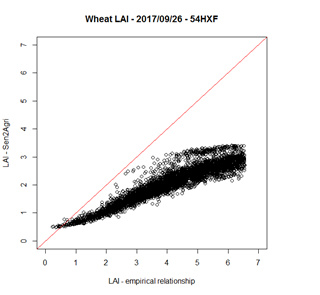Hallo all,
is there a difference between algorithms for LAI provided within SNAP (biophysical processor) and those provided by Sen2agri?
thanks in advance
Marcela
Hallo all,
is there a difference between algorithms for LAI provided within SNAP (biophysical processor) and those provided by Sen2agri?
thanks in advance
Marcela
Hi Marcela,
The two implementations use different algorithms. We are currently evaluating both, but cannot say yet which one gives the best results.
Hi Marcela,
Actually, both methods are based on the same well-known BV-NET approach developped by Weiss et al. (2002). The main difference being that in the Sen2-Agri system implementation, the model is applied to every acquisition date, which allows removing the solar and sensor angles from the predictor variables.
As Laurentiu mentionned, we are currently assessing the option to move back to the original BV-NET implementation which could offer better estimation for higher LAI values. Sen2-Agri implementation is indeed currently suffering from saturation around LAI value of 4.
Nicolas
Hi Nicolas,
Thank you for your contribution which raises some questions : does it mean that in SNAP, BV-NET model doestn’t take into account the solar and sensor angles of the image to estimate biophysical parameters ?
In the ATBD (S2ToolBox Level 2 products), it is written that a global Neural Network is used and that "…the cosine of the sun zenith angle, view zenith angle and relative azimuth angle are used as inputs to the neural networks."
And then (p33) : “Once date and location are sampled, the corresponding geometrical configuration is derived using SENTINEL2 orbit characteristics and swath”.
Does this mean that SAIL model uses random geometrical configuration to build the NN ? If it is the case :
Thanks in advance,
Guillaume
To document the saturation effect, here is a graph showing the LAI from Sen2Agri v1.7 and the LAI obtained using the empirical relationship developed by Nguy-Robertson et al. (2012):
GCVI=1.4 (LAI)^1.3+1.1
with
GCVI= (NIR/Green) - 1

The graph clearly shows a saturation before LAI=4
Nguy-Robertson, Anthony, Anatoly Gitelson, Yi Peng, Andrés Viña, Timothy Arkebauer, and Donald Rundquist. 2012. “Green Leaf Area Index Estimation in Maize and Soybean: Combining Vegetation Indices to Achieve Maximal Sensitivity.” Agronomy Journal 104 (5). The American Society of Agronomy, Inc.: 1336–47
_________________________ UPDATE with Sen2Agri 1.8 ________________________
I used the same approach to compare the LAI processor of version 1.8.
The saturation effect disappears but values are quite different especially for high LAI values.